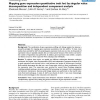BMCBI
2008
13 years 11 months ago
2008
Background: High throughput microarray technologies have afforded the investigation of genomes, epigenomes, and transcriptomes at unprecedented resolution. However, software packa...
BMCBI
2008
13 years 11 months ago
2008
Background: The hierarchical clustering tree (HCT) with a dendrogram [1] and the singular value decomposition (SVD) with a dimension-reduced representative map [2] are popular met...
BMCBI
2008
13 years 11 months ago
2008
Background: Temporal gene expression profiles characterize the time-dynamics of expression of specific genes and are increasingly collected in current gene expression experiments....
BMCBI
2008
13 years 11 months ago
2008
Background: Microarray technology has become very popular for globally evaluating gene expression in biological samples. However, non-linear variation associated with the technolo...
BMCBI
2008
13 years 11 months ago
2008
Background: Microarray techniques are one of the main methods used to investigate thousands of gene expression profiles for enlightening complex biological processes responsible f...
BMCBI
2007
13 years 11 months ago
2007
Background: In many laboratory-based high throughput microarray experiments, there are very few replicates of gene expression levels. Thus, estimates of gene variances are inaccur...
BMCBI
2007
13 years 11 months ago
2007
Background: A major goal of computational studies of gene regulation is to accurately predict the expression of genes based on the cis-regulatory content of their promoters. The d...
BMCBI
2008
13 years 11 months ago
2008
Background: High-density short oligonucleotide microarrays are a primary research tool for assessing global gene expression. Background noise on microarrays comprises a significan...
BMCBI
2008
13 years 11 months ago
2008
Background: Microarray gene expression data are often analyzed together with corresponding physiological response and clinical metadata of biological subjects, e.g. patients'...
BMCBI
2008
13 years 11 months ago
2008
Background: The combination of gene expression profiling with linkage analysis has become a powerful paradigm for mapping gene expression quantitative trait loci (eQTL). To date, ...

